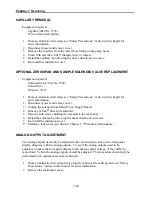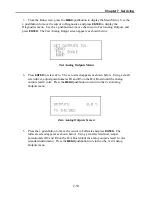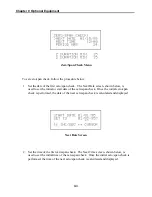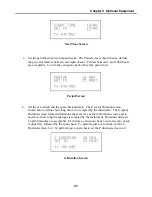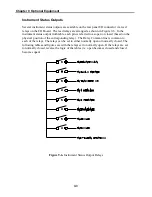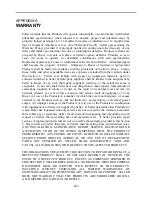
Chapter 8 Theory of Operation
Analog to Digital Board.
The Analog to Digital Board acts as an interface
between all the signals monitored by the processor system and the microprocessor itself.
The internal ambient temperature, internal ambient pressure, and power supply voltages
are converted to digital signals used by the microprocessor.
Digital/Analog Board.
The Digital to Analog Board contains four D/A converters,
one for each analog output. Each is addressed by the processor via signals from PA0-PA7
and PG0 and PG1. The D/A converters are zeroed using potentiometers R2, R4, R6, and
R8. The fullscale output of the four D/A converters is set by jumpers on switches SW1-
SW4 on the D/A board. Fullscale voltages of 10, 5, 1, and 0.1 volts are available.
C-Link Board.
The C-Link Board contains the RS-232 circuitry, clock, and memory
for the datalogger. Incoming RS-232 signals are converted to TTL levels by U3, an RS-
232 driver/receiver. The TTL signals are then interpreted by U5, a 68HC11
microprocessor, which is dedicated to remote communications. Data records from the
internal datalogger are stored in U2, a 128K RAM, and the link program is stored in U6,
a 64K EPROM. U10 is the internal clock. A battery su5 volts to the clock and
the data logger memory when instrument power off.
SOFTWARE
The program is stored on U2 of the Processor Board. Ten times a second the
microprocessor receives a reset pulse. This forces the program into the reset mode,
during which time the status of all pushbuttons are checked, the counters are read, the
timer incremented, etc. If for any reason this does not occur, e.g., if the source burns out,
the chopper motor stops, the optical switch fails, etc., the program will hang up. If this
were to occur, there would be no new update of data. It is important to understand this
for troubleshooting.
Ten pulses equal one second. The Model 48C operates on a ten second cycle. Thus 100
reset pulses corresponds to one full cycle. Every five seconds a signal is sent to the input
signal conditioning board changing which V-F receives the sample signal and which one
the reference signal. After ten seconds, the program determines the running count for the
last forms a ratio of these two signals. Using this information, as well as the pressure and
temperature information determined from the pressure and temperature transducers, and
the calibration information, the Model 48C program determines a linearized, temperature
and pressure corrected CO concentration. Every ten seconds this new information is
presented to the digital display and analog outputs, if a time constant of 10 seconds is set.
Note, the past 30 measurements are stored in memory, thus the values for the past 300
seconds are available.
8-4
Summary of Contents for 48C
Page 4: ......
Page 12: ......
Page 14: ......
Page 18: ......
Page 27: ...Chapter 3 Operation 3 3 Figure 3 2 Flowchart of Menu Driven Software ...
Page 112: ......
Page 116: ......
Page 120: ......
Page 123: ...Chapter 7 Servicing 7 3 Figure 7 2 Model 48C Component Layout 48P737 ...
Page 125: ...Chapter 7 Servicing 7 5 Figure 7 3 Optical Bench Exploded View 42P761 ...
Page 138: ......
Page 146: ...Chapter 9 Optional Equipment 9 2 Figure 9 2 Model 48C Dimensional Outline D42P725 ...
Page 155: ...Chapter 9 Optional Equipment Figure 9 8 Purge Housing Assembly 9 11 ...
Page 158: ......
Page 178: ...Appendix B RS 232 Commands B 20 µ ...
Page 184: ......
Page 186: ...C 2 ...
Page 187: ...C 3 ...
Page 188: ...C 4 ...
Page 189: ...C 5 ...
Page 190: ...C 6 ...
Page 191: ...C 7 ...
Page 192: ...C 8 ...
Page 193: ...C 9 ...
Page 194: ...C 10 ...
Page 195: ...C 11 ...
Page 196: ...C 12 ...
Page 197: ...C 13 ...
Page 198: ...C 14 ...
Page 199: ...C 15 ...
Page 200: ......
Page 201: ...APPENDIX D PUMP MAINTENANCE ...
Page 202: ......
Page 203: ......
Page 204: ......





